What kind of shark is the largest shark in the world? When it comes to ocean predators, size matters. And sharks have a sizable corner of the market on that characteristic. While not all shark species are large, (the Dwarf Lantern, for example, is so small it can fit in a human’s palm) several species can pride themselves in being the largest fish in the sea. As we know, whales can definitely outsize sharks, but they are technically mammals. But what is the biggest shark in the world?
So what fish can even compete in size with sharks? For one, the giant oceanic manta ray can, measuring an average of 23 feet in width and weighing up to 3 tons. The largest bony fish is the Mola Mola, weighing up to 2.3 tons and averaging 10.8 feet in length. But there are four sharks we’ll look at in our top 10 list of the biggest sharks in the world that are all bigger than the aforementioned fish. Which is the largest shark in the world? Read on to find out.
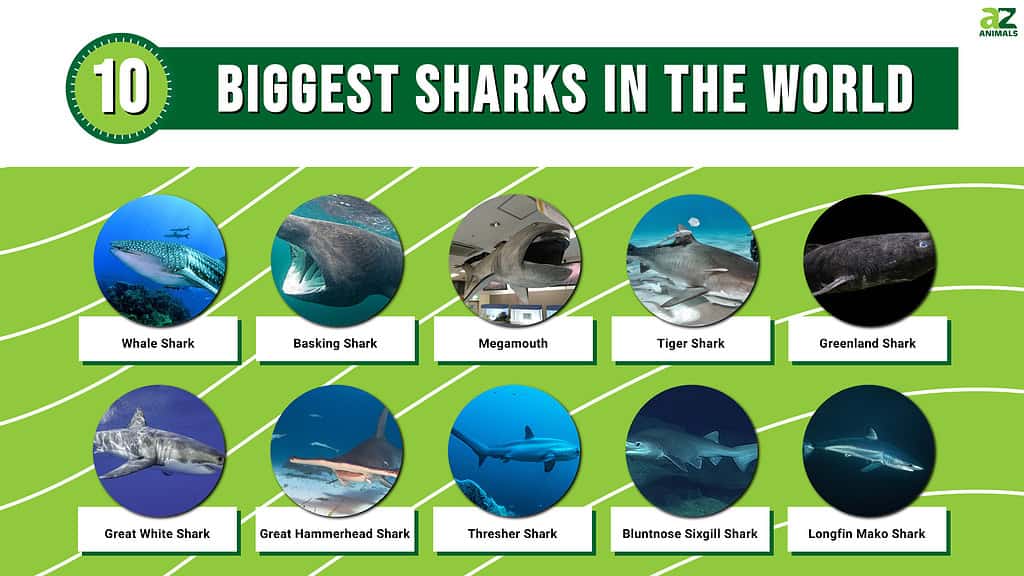
Characteristics of the Biggest Sharks in the World
The human fascination with sharks stems from many of their characteristics. First and foremost, large, carnivorous sharks have been known to kill and eat people, which upends the usual situation of humans killing and eating fish. Another fascinating thing about these fish is that their skeletons are not made of bone, like those of other fish, but of cartilage. Since cartilage is lighter than bone, sharks tend to weigh less than a similar-sized animal with a bony skeleton.
They have 5 to 7 gill openings, and their pectoral fins are supported by pectoral girdles instead of being fused to their heads like other fish. Males also have claspers on each of their pelvic fins to help them fertilize the eggs of females internally. Sharks also lack a swim bladder. Many have huge, oil-filled livers or fill their stomachs with air to keep them buoyant. Since some of these animals need to keep moving lest they sink, they have evolved the ability to swim even as they sleep.
Another fascinating thing about sharks is their skin is made, basically, out of teeth called dermal denticles. This tough skin not only functions as a type of outside skeleton as the muscles that help them swim are attached to it but makes the fish more hydrodynamic as it swims. As for their real teeth, they evolved according to the prey the animal prefers, and they are always being replaced. Sharks can also grow to a huge size, as will be discussed. Despite all of these advantages, a lot of species are endangered thanks to culling, overfishing, pollution, and climate change.
Without further delay, let’s delve into the top ten biggest sharks and answer the question “What is the largest shark in the world?”
#10 Longfin Mako
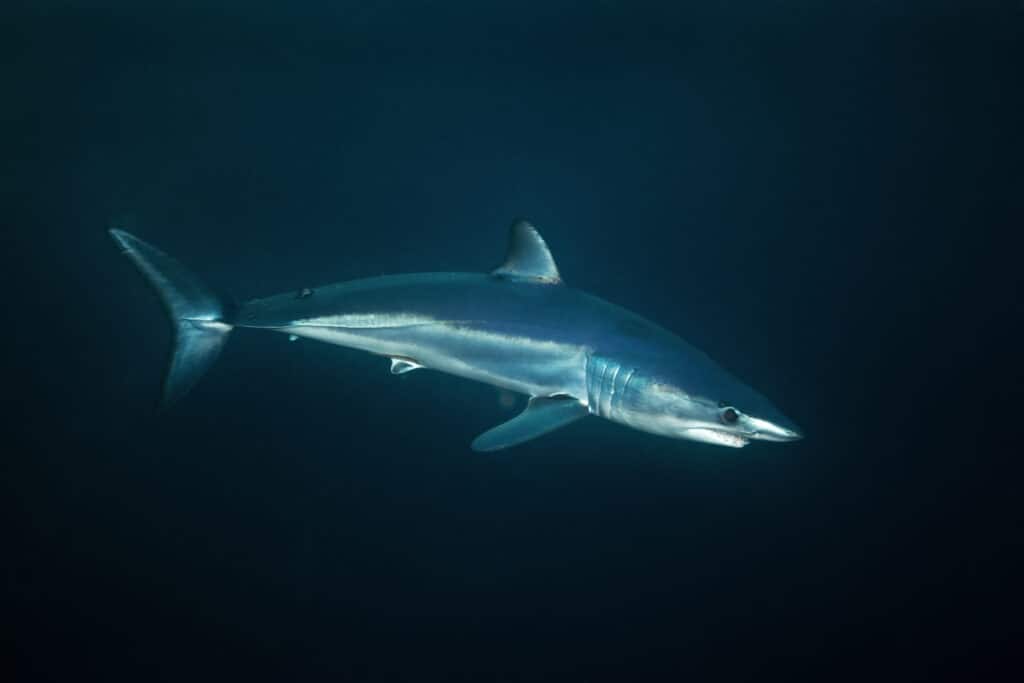
The longfin mako shark has a long, slender body that can reach 14 feet long.
©Martin Prochazkacz/Shutterstock.com
This creature, with disproportionately long pectoral fins, can grow to about 14 feet long. Its long fins make it a less agile swimmer than its relative, the shortfin mako shark. It eats fish, squid, octopus, and cuttlefish and might be able to raise its body temperature. Longfin mako babies hatch from eggs while they’re still inside their mother and she lets them eat unfertilized eggs while they’re still in the womb. Though longfin makos aren’t good eating and are not sought by commercial fishermen, they are still endangered. They’re found around the world in temperate and tropical seas.
#9 Bluntnose Sixgill Shark
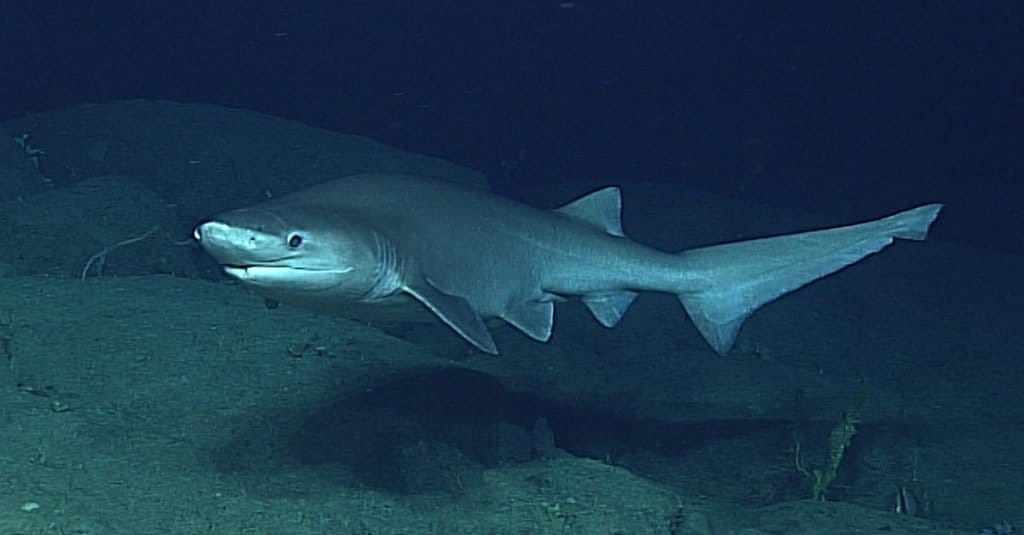
The sixgill shark can grow to 20 feet long.
©NOAA Ocean Explorer from USA / CC BY-SA 2.0 – License
This sixgill shark, which is also found around the world in tropical and temperate seas, grows on average 15.8 feet long but has been known to grow as long as 20 feet. Also called the cow shark, it is found deep in the ocean and eats whatever it can tackle with its protruding jaws, including giant octopuses. As a Hexanchiform shark, it is a rather primitive animal, with a blunt head, small eyes that lack a protective nictitating membrane, and a single dorsal fin. The cow shark is not dangerous to humans unless it’s threatened, and its conservation status is near threatened.
#8 Thresher Shark
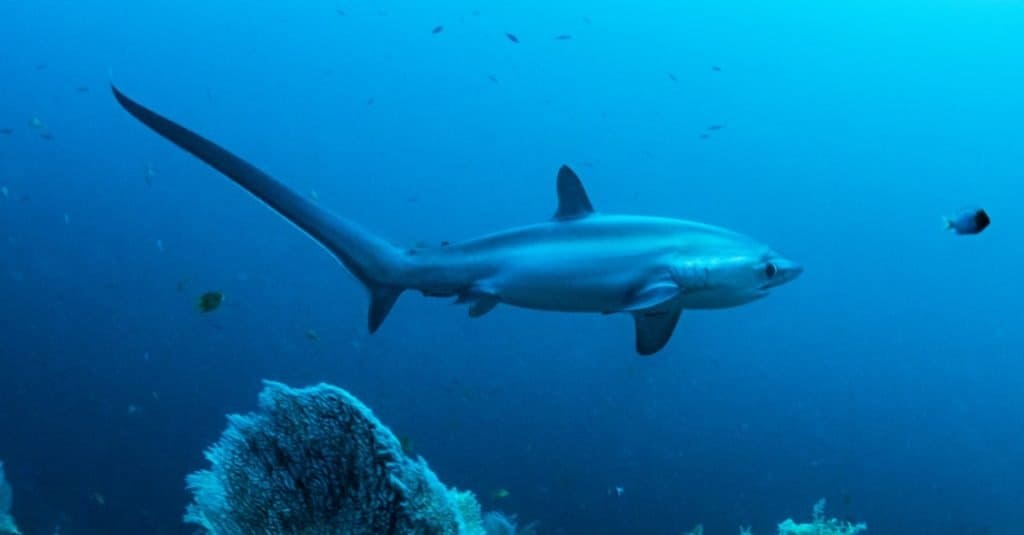
The thresher shark can grow to around 18.8 feet in length.
©Shane Gross/Shutterstock.com
One of the biggest sharks in the world, the thresher shark can grow to around 18.8 feet in length, and much of that length is taken up by its tail, which gives the animal its name and is used to stun its prey. There are three species, and the conservation status of all of them is vulnerable. Still, people hunt them for sport, for shark fin soup, for their meat, and for the oil found in their livers. Leather is even made out of their skin.
Thresher sharks are mainly found in the open ocean, even though now and then one ventures close to the shore, especially if the shore is over a continental shelf. This means the shelves of the North Pacific around Asia and the North American continental shelves.
#7 Great Hammerhead
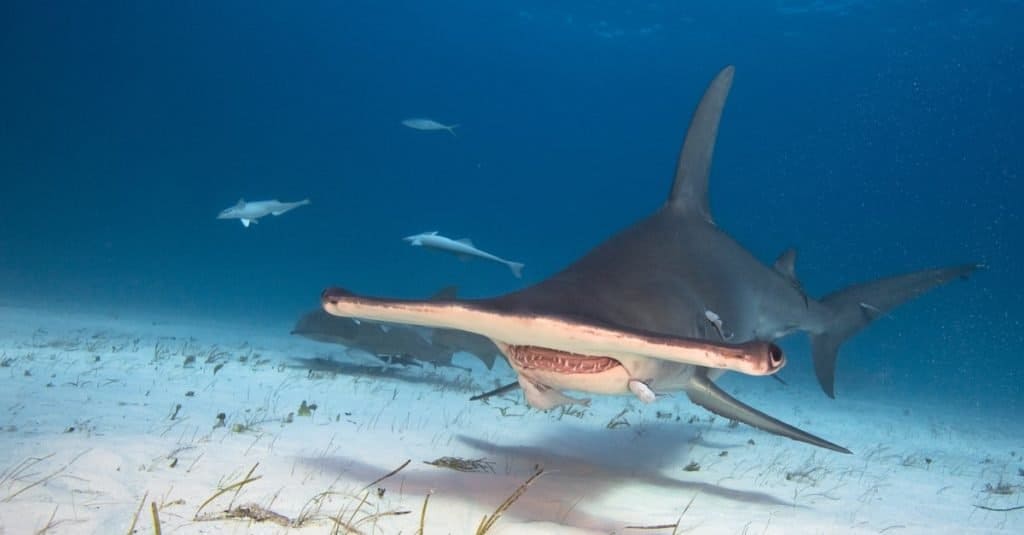
The great hammerhead shark can reach as much as 20 feet long.
©frantisekhojdysz/Shutterstock.com
The great hammerhead shark is the biggest of the hammerheads and is critically endangered. Found in tropical and temperate waters worldwide, it is most likely found near the coast on continental shelves. It’s not only bigger than other hammerheads, but its hammer differs from theirs because it is almost straight across, and the first fin on its back or dorsal fin is tall and curved. Scientists believe that the fish developed its hammer, or cephalofoil to stun stingrays, which is its favorite meal.
The great hammerhead’s size, as much as 20 feet, makes it intimidating, but it rarely attacks humans. Unfortunately, the reverse isn’t true because its long fins are prized for shark fin soup.
Great hammerhead sharks are gravid for about 11 months, then they can give birth to as many as 55 pups. The edges of their hammers are rounder than those of the adults. If they survive to adulthood, great hammerheads can live as long as 50 years.
#6 Great White Shark
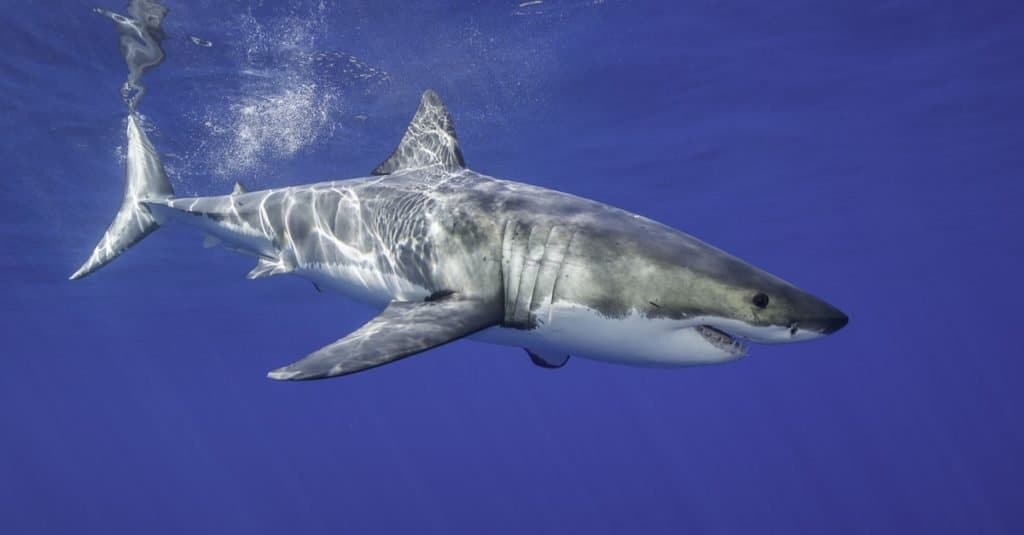
The great white shark generally grows to 20 feet long.
©wildestanimal/Shutterstock.com
While it’s not the largest shark in the world, this huge carnivore, which typically grows to 20 feet in length and weighs two and a half tons, has a fearsome reputation. The reputation is deserved, for if someone is going to be attacked by a shark, it will most likely be a great white. Its conservation status is vulnerable, and it is protected in many areas.
The animal is rarely kept in aquaria because it is a migratory fish that’s used to swimming thousands of miles. It also has a diet that most aquaria can’t provide on a regular basis. This includes pinnipeds, porpoises, dolphins, sea turtles, seabirds, tuna, and other sharks. The great white also has no problem taking chunks out of larger whales.
The fish is found in waters all over the world save at the Poles, with concentrations around Japan, Oceania, Chile, the northeastern United States, and California, and the Mediterranean Sea. Groups seem to prefer to meet in the North Atlantic because of the eddies of warm water found there.
#5 Greenland Shark

Greenland sharks aren’t adults until they’re around 150 years old and keep growing their whole lives.
©Dotted Yeti/Shutterstock.com
This 24-foot-long fish is one of the longest-lived creatures on Earth. Biologists believe it can live as long as 500 years. It doesn’t even start to reproduce until it’s between 100 and 150 years old. Because it lives so long and reproduces so slowly, efforts are being made to protect this animal, whose conservation status is vulnerable.
The Greenland shark eats fish and squid found in the cold waters of the North Atlantic and the Arctic. The fish actually comes upon its prey while the prey is asleep and simply sucks it whole into its mouth. It has also been found with the remains of mammals in its stomach, but scientists believe this is from scavenging.
Because it has a lot of trimethylamine N-oxide, the flesh of the Greenland shark is poisonous to humans.
#4 Tiger Shark
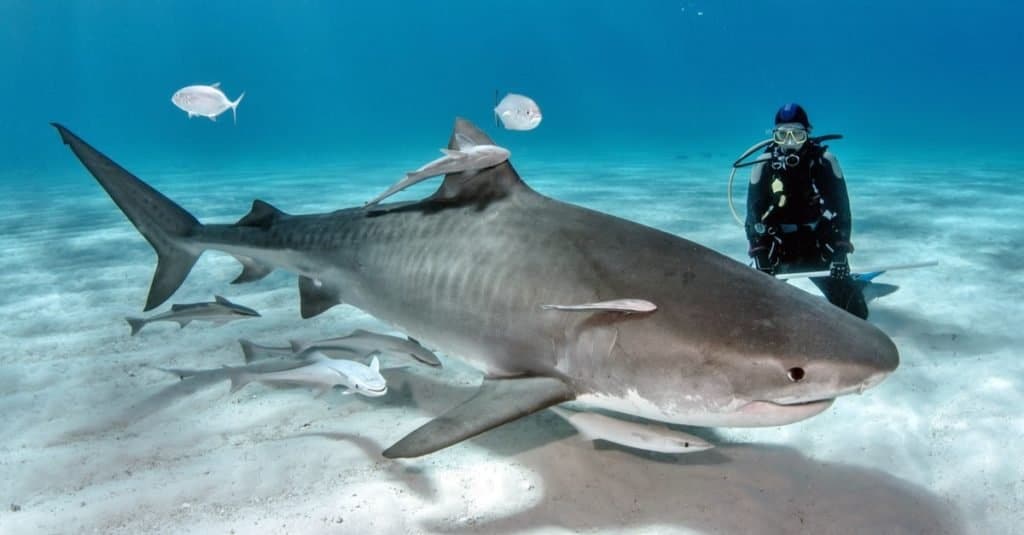
Tiger
sharks can reach up to 24.6 feet long.
©Tomas Kotouc/Shutterstock.com
The tiger shark, which can grow to 24.6 feet long, gets its name for the stripes found on its body and probably not for its ferocity. Still, only the great white has killed more humans. But is it the largest shark? Not quite.
The tiger shark is famous for eating anything it can get its impressive jaws around. It matters not if the object is edible. Edible prey include seals, squid, sea turtles, dolphins, fish, jellyfish, crustaceans, other sharks, and injured whales as large as humpbacks. It is found most often near the coast in warmer waters, and it prefers to stay close to the equator, though it’s been found as far north as Japan.
#3 Megamouth

Megamouth sharks can reach 35 feet in length.
©Opencage / CC BY-SA 2.5 – License
The three biggest sharks in the world are plankton feeders and completely harmless to human beings. The “smallest” of these sharks is the megamouth shark at 25 feet in length. This fish lives in deep waters and is elusive, with a huge head, a flabby body, a thresher-like tail, and prominent lips. The megamouth has been seen off Japan, Hawaii, and California and can dive to a depth of 3,280 feet. Though its mouth is huge, its teeth are small and useless. It keeps its mouth open as it swims to pull in plankton and other small prey such as jellyfish.
#2 Basking Shark

The most impressive feature of the basking shark is its mouth, which opens up to 1 meter wide.
©Martin Prochazkacz/Shutterstock.com
At nearly 50 feet long, the basking shark comes in second as the largest shark in the world. It is found all over the world in temperate water and moves slowly, its mouth gaping to take in plankton. It gets its name because it’s often found feeding at the water’s surface, appearing to bask in the sunlight. It has hundreds of teeth, but they are small, curved, and don’t do much. The fish depends on its gill rakers to catch the plankton as it’s pulled into the mouth along with seawater. Unsurprisingly, gill rakers get worn out and are replaced and regrown continuously.
This animal has been overfished for its meat, its fins, its liver oil, and for animal food. Its conservation status is endangered. Basking sharks swim thousands of miles in the summer and winter in search of rich feeding grounds.
#1 Whale Shark

A whale shark is the biggest fish in the world at around 55.7 feet long.
©weera bunnak/Shutterstock.com
What is the biggest shark in the world? The whale shark is not only the largest shark in the world at about 55.7 feet in length, but it is the biggest fish in the world. It is considered a carpet shark because of the beautiful pattern on its hide, which is dark gray with white stripes and what looks like polka dots. These animals also have two dorsal fins and five gill openings. They usually have small mouths. This doesn’t quite apply to the whale shark, though its mouth is smaller than that of the basking shark or megamouth. The whale shark simply opens its mouth and swims forward, which allows food and seawater to enter its mouth, or it sucks the prey in. This includes not only plankton but fish eggs, small fish, small squid, and krill. The fish has also been seen to cough to clear its throat of debris.
The whale shark has dermal denticles not only on its body but on its eyes. Like those on the body, they are there for protection. The animal can also retract its eyes completely into its body. It is found in warmer waters in the open ocean and near the coast and is endangered.
How Do Sharks Grow So Large?
Certain shark species are some of the largest fish in the sea. How do they get to be so large? Well, genetic predisposition definitely plays a role in many of these species, along with the environment, food availability, competition, etc.
Summary: 10 Biggest Sharks in the World
| Rank | Shark | Size |
|---|---|---|
| 1 | Whale shark | >55 ft |
| 2 | Basking shark | 50 ft |
| 3 | Megamouth | 25 ft |
| 4 | Tiger shark | 25 ft |
| 5 | Greenland shark | 24 ft |
| 6 | Great white shark | 20 ft |
| 7 | Great hammerhead shark | 20 ft |
| 8 | Thresher shark | >18 ft |
| 9 | Bluntnose sixgill shark | <20 ft |
| 10 | Longfin mako shark | 14 ft |
Bonus Sharks That Didn’t Make The List!

Pacific
sleeper sharks
are commonly found in colder waters near the Arctic region.
©shweta.onlinetester/Shutterstock.com
This article has featured an impressive list of the ten largest sharks. However, not finding some species on this list doesn’t mean there aren’t many other species of big sharks in the wild!
Here are some bonus sharks that didn’t make the list:
- Pacific sleeper shark
- Bluntnose sixgill shark
- Oceanic whitetip shark
- Tope shark/school shark
The Pacific sleeper shark (Somniosus pacificus) is a member of the Somniosidae family and is primarily located in the North Pacific, inhabiting continental shelves and slopes in the Arctic region.
Additionally, the bluntnose sixgill shark which is commonly referred to as the cow shark, is the largest species among hexachord sharks, capable of reaching lengths of up to a staggering 20 feet.
The oceanic whitetip shark is another sizable pelagic requiem shark found in tropical and warm temperate seas. It boasts a robust body with elongated, rounded fins that are tipped with white.
Furthermore, the school shark belongs to the hound shark family Triakidae and stands as the sole representative of the Galeorhinus genus. It goes by several common names, including tope, tope shark, snapper shark, and soupfin shark.
The photo featured at the top of this post is © Matt9122/Shutterstock.com
Thank you for reading! Have some feedback for us? Contact the AZ Animals editorial team.






